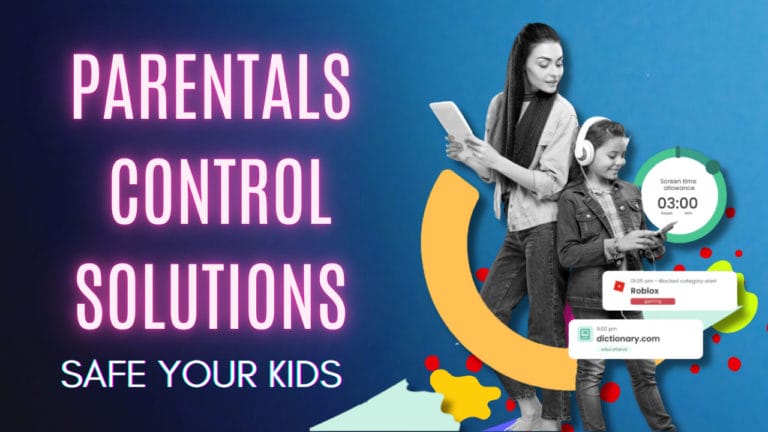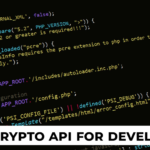Languages are all cool until you travel somewhere else, lol, things get really tough, I mean how would I ask for milk and bread in german if I wanted to, not that I am financially capable enough to go there, oh let’s not divert from the topic, so the point is, translation is needed in one way or another in any point of your life, you can always use Google Translate but what if you wanted to build your own solution, that would require APIs right? So here in this article we have compiled the list of Best Translation APIs
Translation APIs, or Application Programming Interfaces, are tools that allow developers to integrate automated language translation capabilities into their applications, websites, or services. These APIs leverage machine learning and natural language processing algorithms to translate text from one language to another, enabling seamless communication and content localization across diverse linguistic landscapes. Translation APIs provide a standardized way for developers to access and utilize translation services without having to build the translation functionality from scratch.

Table of Contents
Key features and functionalities of translation APIs include:
- Text Translation: The primary function is to translate text from one language to another. This includes the translation of phrases, sentences, paragraphs, or entire documents.
- Language Detection: Many APIs can automatically detect the language of a given text, which is useful when the source language is unknown.
- Multilingual Support: Translation APIs support a wide array of languages, allowing developers to cater to a global audience with diverse language requirements.
- Contextual Understanding: Advanced APIs aim to preserve the context and meaning of the text during translation, producing more accurate and contextually relevant results.
- Speech Translation: Some APIs offer the capability to translate spoken language in real-time, making them suitable for applications involving voice communication.
- Domain-Specific Translation: Certain APIs are specialized for specific domains, such as legal, medical, or technical translations, providing more accurate results in these contexts.
- Customization: Some translation APIs allow developers to customize translation models based on specific terminology or industry jargon.
Developers can integrate these APIs into their applications to provide users with the ability to translate content on-the-fly, support multilingual communication, and facilitate the localization of digital content. Translation APIs are widely used in various industries, including e-commerce, content management, social media, and communication platforms, to bridge language barriers and enhance user experience on a global scale.
How do translation APIs work?
Translation APIs work by processing input text through advanced machine learning models and algorithms. These models analyze the structure and context of the text to generate accurate translations. These APIs often use neural machine translation techniques to understand the relationships between words, phrases, and sentences, preserving context and producing contextually relevant translations.
What languages are supported by translation APIs?
Translation APIs typically support a wide array of languages, including popular ones like English, Spanish, Chinese, French, and many others. The level of language support may vary among different APIs, so developers should check the documentation for the specific languages supported by a particular API.
How accurate are translation APIs?
The accuracy of translation APIs depends on the underlying machine learning models and algorithms. Leading APIs, especially those using neural machine translation, can provide high levels of accuracy. However, the accuracy may vary for complex or domain-specific content. Developers may need to evaluate multiple APIs to find the one that best suits their accuracy requirements.
Are there any security considerations when using translation APIs?
Security measures for translation APIs vary by provider but often include authentication mechanisms such as API keys, OAuth tokens, and encrypted connections (HTTPS). Developers should follow best practices for securing API keys and transmitting data securely, especially when dealing with sensitive or confidential information.
Can translation APIs be used for real-time translation?
Yes, many translation APIs support real-time translation, allowing developers to implement features like instant messaging or live chat translation in their applications. APIs with speech translation capabilities also enable real-time translation of spoken language.
How can developers choose the right translation API for their needs?
To choose the right translation API, developers should consider factors such as the range of languages supported, accuracy, contextual understanding, ease of integration, pricing models, and any additional features like speech translation or domain-specific capabilities. Reading documentation, trying out free tiers, and reviewing user feedback can help in making an informed decision.
Also Read ➤ ➤ 10 Best Crypto API for Developers
The Main Agenda – Best Translation APIs

Google Cloud Translation API
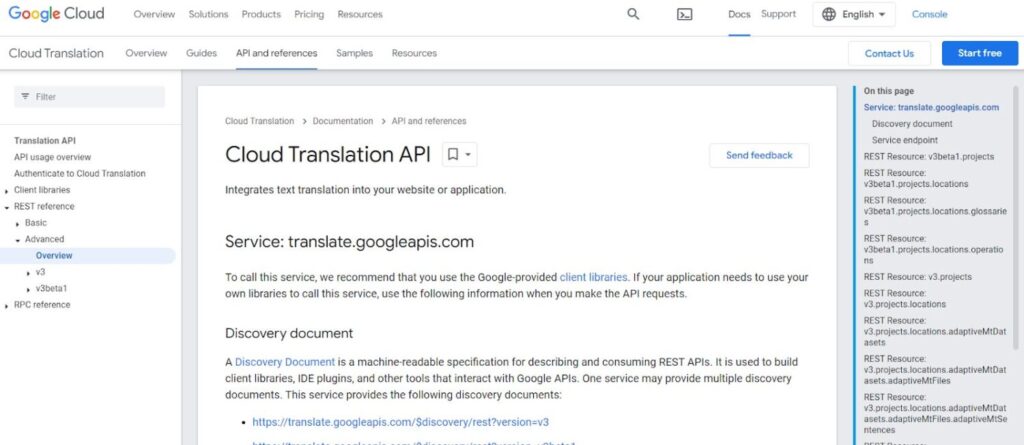
Google Cloud Translation API is a powerful language translation service by Google that allows developers to integrate translation capabilities into their applications. It supports a wide range of languages and provides advanced features such as automatic language detection, translation of text, and even website content. One unique point is its integration with Google’s extensive machine learning models, ensuring high-quality translations. The API is user-friendly and offers seamless integration with other Google Cloud services, making it a preferred choice for developers looking for a robust and scalable translation solution.
Google Cloud Translation API stands out for its accuracy and extensive language support. The integration with Google’s machine learning models enhances the quality of translations, making it suitable for various applications. Its user-friendly documentation and seamless integration with other Google Cloud services simplify the development process. Additionally, the API offers a pay-as-you-go pricing model, allowing developers to pay only for the resources they consume.
While the API excels in accuracy, the pricing structure may be a consideration for smaller projects with budget constraints. Some developers may find the learning curve steep when integrating advanced features, requiring a deeper understanding of Google Cloud services. Furthermore, occasional latency in translation updates might be observed, which could impact applications requiring real-time translation with extremely low latency.
Also Read ➤ ➤ Top 10 Development Service Providers
Microsoft Translator API

Microsoft Translator API is a language translation service that allows developers to integrate translation features into their applications. One notable point is its seamless integration with Microsoft’s ecosystem, providing developers with comprehensive language translation capabilities. The API supports a wide range of languages, offers language detection, and can handle both text and speech translation. Its versatility makes it suitable for various industries, from e-commerce to healthcare.
Microsoft Translator API is lauded for its extensive language support, making it a versatile choice for applications targeting diverse global audiences. The API integrates well with Microsoft’s ecosystem, allowing for seamless collaboration with other Microsoft services. Its support for both text and speech translation adds an extra layer of functionality for developers. Additionally, Microsoft provides a user-friendly dashboard for monitoring usage and managing translation resources.
While the API is feature-rich, developers may find that certain advanced features require a deeper understanding of Microsoft Azure services. The pricing structure, while offering a free tier, may become a consideration for projects with high translation volumes or specific premium features. Some users have reported occasional delays in translation updates, which could be a factor for applications requiring real-time translation with minimal latency.
IBM Language Translator API

IBM Language Translator API is a comprehensive language translation service offered by IBM Cloud. This API allows developers to build applications that can translate text from one language to another, supporting a wide array of languages and language pairs. A unique point is IBM’s emphasis on domain-specific translation models, making it suitable for industries with specialized terminology. The API also provides the ability to customize models, allowing developers to fine-tune translations based on specific needs.
IBM Language Translator API stands out for its domain-specific customization, enabling accurate translations in specialized fields such as legal or medical domains. The API’s support for a large number of languages and its ability to handle complex sentence structures contribute to its versatility. IBM Cloud’s robust infrastructure ensures reliability, and the API offers a free tier for developers to explore its capabilities.
While the customization options are a strength, some developers may find the process of fine-tuning models more complex compared to other APIs. The pricing structure for higher usage levels or premium features may be a consideration for projects with budget constraints. Users have reported occasional delays in model training and updates, which could impact real-time translation applications.
Also Read ➤ ➤ Best AI APIs For Developers 2024
DeepL API

DeepL API is known for its advanced neural machine translation capabilities, providing developers with access to high-quality language translation services. The API supports various languages and language pairs, offering accurate and contextually relevant translations. A unique point is DeepL’s focus on preserving the nuances and natural flow of the translated text, making it suitable for a wide range of content types.
DeepL API excels in delivering accurate and contextually relevant translations, especially for complex or creative content. Its intuitive API documentation and straightforward integration process contribute to a positive developer experience. The API provides a free subscription plan with limited features, allowing developers to test its capabilities before opting for a paid plan.
While DeepL offers a free plan, it has limitations, and developers may need to subscribe to a paid plan for higher usage levels or additional features. The API’s pricing structure may be a consideration for projects with substantial translation volumes. Some users have reported occasional latency in updates, which could be a factor for applications requiring real-time translation with minimal delay.
Azure Translator API

Azure Translator API is part of Microsoft’s Azure Cognitive Services, providing developers with language translation capabilities. The API supports a wide range of languages and language pairs, offering text translation, language detection, and speech translation features. A unique point is its integration with Azure’s cloud services, allowing seamless collaboration with other Azure tools and services.
Azure Translator API benefits from Microsoft’s extensive language support and ecosystem integration. Its support for both text and speech translation adds versatility for developers working on applications with diverse communication needs. The API offers a user-friendly dashboard for monitoring usage and managing translation resources, contributing to an efficient development process.
While the API offers a free tier, developers may need to consider the pricing structure for higher usage levels or specific premium features. Some users have reported occasional delays in translation updates, which could impact applications requiring real-time translation with minimal latency. The learning curve for integrating certain advanced features may be steep for developers less familiar with Azure services.
Also Read ➤ ➤ 8 Best Cryptocurrency APIs for Developers [January 2024]
MyMemory Translation Memory
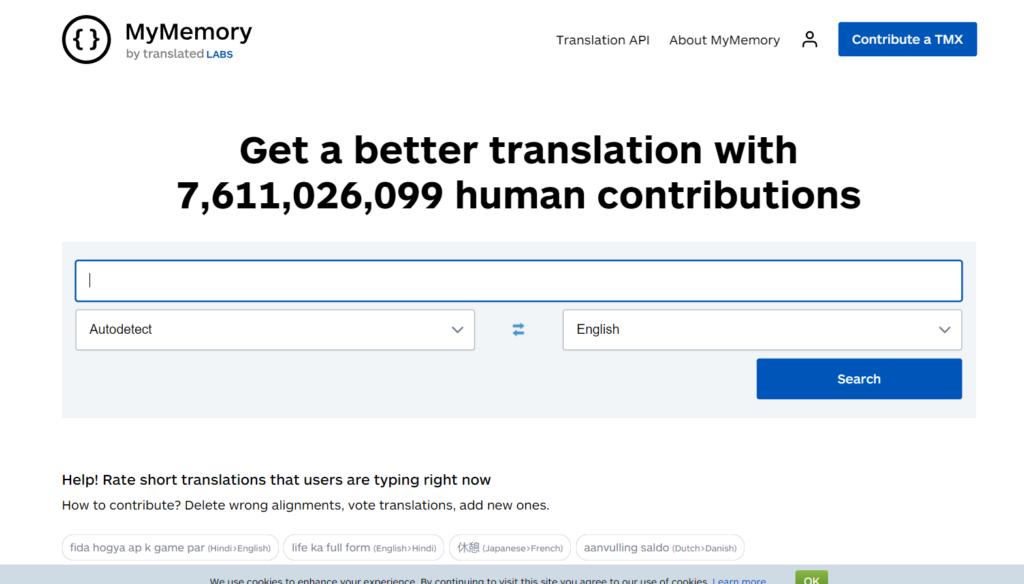
MyMemory Translation Memory is a language translation service that leverages a collaborative translation memory database. The API allows developers to access a vast repository of translated content, contributing to more accurate and contextually relevant translations. One unique point is its reliance on user-generated translations, making it a community-driven resource for language translation.
MyMemory Translation Memory stands out for its extensive database of user-generated translations, providing a diverse set of language pairs and contextually rich content. The API offers a free tier for developers to explore its capabilities, making it a cost-effective option for certain projects. Its community-driven approach ensures a continuous expansion of language resources.
While the user-generated database contributes to diversity, it may also result in varying translation quality depending on the content. The API’s reliance on community contributions might pose challenges for applications requiring highly accurate and specialized translations. Developers may encounter limitations in terms of customization and control over translation models compared to other APIs.
NLP Translation
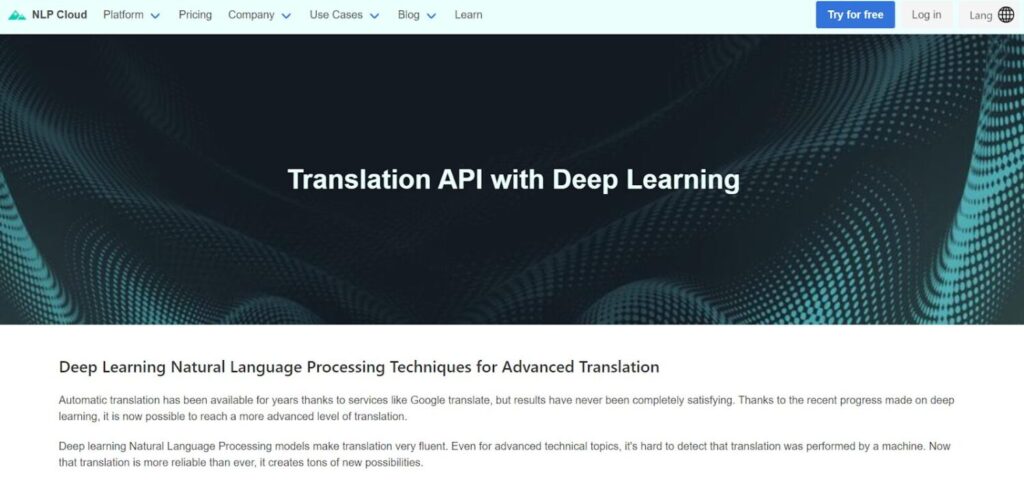
NLP Translation, offered by NLP Cloud, is a deep learning-based language translation API. It enables developers to integrate natural language processing capabilities into their applications, supporting text translation for various language pairs. A unique point is its focus on deep learning techniques for enhanced accuracy and context-aware translations.
NLP Translation excels in providing accurate and context-aware translations through its utilization of deep learning techniques. The API’s straightforward integration process and comprehensive documentation contribute to a positive developer experience. NLP Cloud offers a free tier with basic features, allowing developers to test the API’s capabilities before committing to a paid plan.
While the free tier is advantageous, developers may need to subscribe to a paid plan for higher usage levels or advanced features. The API’s pricing structure may be a consideration for projects with substantial translation volumes. Some users have reported occasional latency in updates, which could be a factor for applications requiring real-time translation with minimal delay.
Also Read ➤ ➤ 5 Best NFT APIs to Track all the NFT Data [January 2024]
Amazon Translate

Amazon Translate is a language translation service offered by Amazon Web Services (AWS). The API allows developers to integrate translation capabilities into their applications, supporting a variety of languages and language pairs. A unique point is its integration with other AWS services, providing a seamless experience for developers within the Amazon cloud ecosystem.
Amazon Translate benefits from Amazon’s robust cloud infrastructure, ensuring reliability and scalability. Its integration with other AWS services allows developers to create comprehensive solutions within the Amazon cloud ecosystem. The API offers a pay-as-you-go pricing model, providing flexibility and cost-effectiveness for varying usage levels.
While the API is feature-rich, developers may need to consider the pricing structure for higher usage levels or specific premium features. Some users have reported occasional delays in translation updates, which could impact applications requiring real-time translation with minimal latency. The learning curve for integrating certain advanced features may be steep for developers less familiar with AWS services.
Also Read ➤ ➤ 10 Best Finance APIs EVER | Check out NOW! 2024
Conclusion
The guide talks about the main features and functions of Translation APIs, like translating text, figuring out the language, supporting multiple languages, understanding context, translating speech, focusing on specific fields, and giving options for customization. It explains the technology behind these APIs, highlighting that Translation APIs use machine learning and natural language processing methods to make translations accurate and suitable for the context.
When we look into specific Translation APIs, like Google Cloud Translation API, Microsoft Translator API, IBM Language Translator API, DeepL API, Azure Translator API, MyMemory Translation Memory, NLP Translation, and Amazon Translate, the article gives us a deeper understanding of their special qualities, advantages, and disadvantages. Each API has its unique features, such as Google using machine learning, Microsoft blending into its ecosystem, IBM allowing customization for specific fields, DeepL concentrating on preserving subtleties, and Amazon smoothly working with AWS services.



